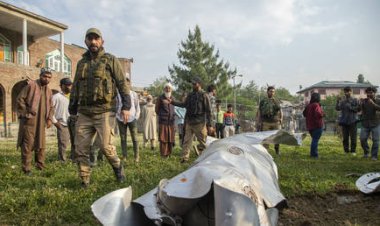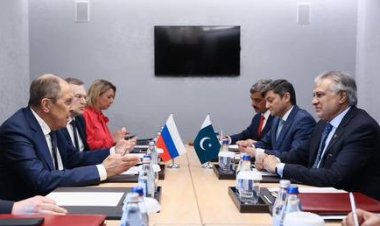The Dangerous and Frightening Disappearance of the Nuclear Expert
Tensions among nuclear powers are rising, but decades of peace have resulted in a dearth of people trained to deal with the continuing threat.


SANTA MONICA, Calif. — At the height of the Cold War, the RAND Corporation crackled with the collective energy of the best brains the Pentagon could find to tackle the biggest threat.
At lunchtime, an eclectic group of physicists, economists and social scientists would play Kriegspeil, a form of double-blind chess modeled on Prussian wargames in which players can’t see their opponent’s pieces and infer their moves from a referee sharing sparse information. Then they would spend the rest of the workday developing the military doctrine, deterrence theory and international arms control frameworks to prevent nuclear war — and if all else failed, how they might win one, or at least avoid total annihilation.
It’s been several decades since the likes of Herman Kahn, the alpha male of the so-called “Megadeath Intellectuals” whose famous book On Thermonuclear War casually contemplated the long-term prospects for a society that had endured the sudden extinction of more than 100 million people, roamed RAND’s halls. The favored lunchtime competition these days seems to be ping pong in the courtyard — if anyone’s around.
One recent morning, I visited RAND’s headquarters here on the scenic California coast. After being escorted past three layers of security, I found Ed Geist, the intellectual heir to those legendary Cold Warriors, holding down the fort in the “Coffee Cove” in the RAND library.
Geist, who holds a Ph.D. in Russian history and is author of the forthcoming book Deterrence Under Uncertainty: Artificial Intelligence and Nuclear Warfare, said the Pentagon-funded think tank’s team of dedicated nuclear policy experts and strategists, spread across half a dozen offices worldwide, could barely fill a couple tables in the lunchroom now. And many of the ones who are left, he said, are in the twilight of their careers.
“It is much, much reduced,” he said, framed by obscure periodicals with titles like North Korean Review, Phalanx and Strategic Policy. “We have more work than we can do.”

He cited a backlog of requests from military commanders and Pentagon policy chiefs for advice on how to contend with a resurgent nuclear threat from Russia, China’s massive nuclear buildup and the increasingly likely prospect that more outlaw states like Iran will soon have the bomb.
“Part of it is just trying to get people up to speed,” explained Geist, 39. “During the Cold War, a lot of people learned on the job, so a lot of it isn’t written down anywhere — or at least isn’t easily accessible.”
This summer, as the public is treated to a rare thriller about the development of the atomic bomb in director Christopher Nolan’s biopicOppenheimer, the nation’s leading nuclear policy wonks like Geist are more concerned than ever about the specter of a nuclear war — and warn that we are far less prepared than during the Cold War to deal with a more expansive threat. As Oppenheimer reminds us, the bomb itself was the creation of a relatively small number of geniuses assigned to the New Mexico desert in the waning days of World War II. But once it was unleashed and other major powers followed, an entire nuclear complex employing thousands of weapons engineers and technicians, political and social scientists, and diplomats sprang up to harness a humanity-erasing technology and fashion strategies to prevent the unthinkable.
Over time, however, the pervasive fear that fueled that intellectual apparatus has ebbed — and with it the urgency to restock the ranks of experts. Three decades after the Cold War ended, RAND and the broader network of government agencies, national laboratories, research universities and think tanks are struggling to meet the demands of a new — and many contend, far more dangerous — chapter in the global nuclear standoff.

The discipline’s steady decline, which only accelerated following the Sept. 11 attacks when the military pivoted to the war on global terrorism, is compounded by reduced funding from some of the leading philanthropies that funded nuclear policy studies and the graying of the last generation of practitioners both in and out of government. As for government funding, most of it — to the tune of $75 billion a year over the next decade — is dedicated to overhauling the U.S. arsenal of nuclear-armed missiles, bombers and submarines, far eclipsing investments in the humans who manage them.
More than a dozen experts across the ideological spectrum I spoke with — hawks and doves alike — agreed a renaissance is needed to rebuild lost muscle memory and fashion new strategies to deter increasingly belligerent nuclear peers and new wannabe nuclear states. And the emergence of artificial intelligence, some analysts fear, could enhance an aggressor’s nuclear first-strike capability or sow dangerous confusion among atomic adversaries.
“There just aren’t that many people who have made this a career,” said Jon Kyl, the former Republican senator from Arizona who is presiding over the bipartisan Congressional Commission on the Strategic Posture of the United States, which is poised to deliver recommendations next month on nuclear threats and strategy. “And there aren’t many of the old-timers around,” he told me. “There is a lot of wisdom that was lost.”

During the Cold War, “the nuclear weapon was the doomsday machine. It was the threat,” Rose Gottemoeller, a former deputy secretary-general of NATO and lead U.S. arms control negotiator who is also a member of the commission, told me. “The shock and trauma of the nuclear age has faded. There are other existential threats out there.”
She told me that recent experience with her students at Stanford University’s Center for International Security and Cooperation underscores how the appeal of other national security pursuits is greater than nukes to many of the new generation. She said the role of other, more modern technologies in national security — such as AI, or cyber warfare — often trump the nuclear portfolio.
“This is an old technology,” Gottemoeller explained. “For young people today, they are a bit of a yawn. They are profoundly an existential threat to mankind, but they are not at the cutting-edge of technology and young people aren’t as interested in them.”
Joan Rohlfing has been sounding the alarm about the trend for years.
For the last 13 years, the former top nuclear adviser at the Departments of Defense and Energy and staffer for the House Armed Services Committee, has been president of the Nuclear Threat Initiative. The nonprofit, founded in 2001 by media mogul Ted Turner, is dedicated to reducing the dangers of weapons of mass destruction. And it has emerged as the standard bearer — and often lead funder — of training programs and policy work that is central to government nuclear strategies.
“This is perhaps the most dangerous point in the history of the nuclear age,” she told me.
Even more than the 1962 Cuban Missile Crisis, in which Washington and Moscow came to the brink of nuclear war? I asked. Yes, she responded, contending the historical record shows Soviet leaders were genuinely seeking to resolve the escalating crisis after having been caught secretly placing nuclear tipped missiles 90 miles from American shores.
“That may sound alarming,” Rohlfing acknowledged, “but I have deep concerns that we are underestimating the dangers of the moment. There is a lot more complexity, with more nuclear weapons states, with more lethal weapons, with weapons that fly faster on hypersonic vehicles.
“And on top of all that,” she stressed, “there is a hot war in Europe with nuclear threats being made.”
Indeed, few predicted the extent to which the Russian nuclear menace would return with such a vengeance. And the startling nuclear saber rattling from Moscow has only risen as its battlefield fortunes in Ukraine have fallen. Of particular concern for U.S. and European officials was a recent article by a leading strategist with ties to the Kremlin who concluded that for too long “we thoughtlessly set too high a threshold for the use of nuclear weapons.” He recommended a limited nuclear strike to break Ukraine — and the West’s — will. The article asserts that the chances the United States would respond with nuclear weapons and risk retaliatory strikes on American cities would “be reduced to an absolute minimum” and reflects a much greater willingness to climb the ladder of nuclear escalation than during the Cold War.

Meanwhile, the arms control agreements that Washington and Moscow relied on for decades to bring some measure of stability and transparency to the world’s largest nuclear arsenals —including requiring reciprocal visits of each other’s weapons bases — have become another casualty of degrading relations between the United States and Russia in recent years.
Warnings are growing that the West is simply not up to snuff. Some analysts steeped in the region are calling for a major review of both the quantity and quality of both post-Soviet area and nuclear strategy studies. A recent essay, for example, cited far fewer courses offered at elite universities and almost nothing on Ukraine or other former Soviet republics. The essay’s authors blamed this dearth of serious, broad-based academic inquiry for the West’s failure to predict Russia’s all-out invasion of Ukraine in 2022.
“Knowledge is power,” they wrote. “This includes the power to prevent wars by knowing who is capable of what, what to expect, and what is at stake.”
Perhaps the biggest difference from the Cold War-era theorizing about nuclear deterrence has been China’s “breakout,” as the Pentagon calls it, to field a nuclear arsenal on par with the United States and Russia.
The Pentagon has estimated that Beijing could quadruple its deployed warheads to 1,000 by 2030, uncomfortably close to the number of nuclear weapons that Moscow and Washington have deployed. But China is not party to any arms control agreements or international limits. “We have not built a good foundation for these discussions with the Chinese,” says Geist, the RAND nuclear expert.
Meanwhile, successive government studies and think-tank reports warn about the threat of cyber-attacks on nuclear command and control systems that could lead to deadly miscalculation. Add to the mix the uncharted territory of AI, the race to develop new weapons that can destroy early warning or communications satellites in orbit, and the failure of the international community to prevent North Korea and Iran from building up their nuclear weapons complexes.
“All the ingredients are here for a catastrophe,” Rohlfing said. “I think there is a high degree of denial because we have gone so long without nuclear use. We are discounting the warning signs that are right in front of us. In the heat of the moment, all it takes is a miscommunication or miscalculation to create a series of events that spiral out of control.”

Yet the level of the threat is not matched by the brain power needed to confront it, she said.
Rohlfing pointed to a 2019 assessment of the nuclear arms control and disarmament community that painted a decidedly gloomy outlook for a field that was once vibrant. It singled out the arm of the Department of Energy responsible for both building and certifying the nuclear warheads for the U.S. arsenal and working to prevent the further spread of nuclear weapons around the world.
“By 2023, nearly 40 percent of the National Nuclear Security Administration’s employees will be eligible for retirement,” stated the report by N Square. “If a new generation of experts cannot be recruited to replace those who are stepping down, the branches of government responsible for nonproliferation and disarmament will be unable to do their work.” The agency has an estimated 50,000 employees and contractors at weapons labs, plants and other facilities.
That demographic trend is now the norm for many working in the nuclear weapons space. “I am still one of the youngest people in the room when I walk into a room full of nuclear weapons experts,” Tim Morrison, 45, who has handled the nuclear portfolio for Republicans in Congress and served as the top nuclear policy adviser to former President Donald Trump, told me recently.
Compounding the problem is that the John D. and Catherine T. MacArthur Foundation, the leading philanthropy that for four decades was a top donor to nuclear policy programs at universities, think tanks and other research institutions halted its support for the discipline two years ago. Between 2015 and 2021, it directed 231 grants totaling more than $100 million to “nuclear challenges” and, by some estimates, accounted for more than half of all non-government nuclear funding. But it concluded that it wasn’t achieving its goals and shifted to other disciplines such as climate change and public health. That has deprived a host of research centers and grassroots organizations dedicated to reversing the spread of nuclear weapons of much-needed funding to build a new generation of nuclear thinkers.
“The capacity in the field is shrinking as the threat is expanding,” said Rohlfing. “Nuclear is woefully neglected.”
Mark Bucknam arrived at the National War College in 2010. He discovered the leading academic institution for training military, diplomatic and foreign leaders in national security strategy was bestowing masters degrees without any instruction on nuclear deterrence, which had been a pillar of the curriculum in the years before the 9/11 attacks.
“There was no course on nukes,” the retired Air Force colonel, who holds a Ph.D. in war studies from King’s College in London, recently told me. He said students instead got the bare minimum: “One day when they got a lecture on nukes.”
Yet not much has changed, in the view of multiple experts.
The Biden administration’s 2022 Nuclear Posture Review, which set goals for modernizing the U.S. nuclear arsenal and deterring a growing number of potential nuclear adversaries, gives priority to “recruiting and retaining a skilled and diverse workforce,” while acknowledging there is “no quick fix.”
“Since the Cold war we have just forgotten how to think about it,” Bucknam said. “Nukes were central to our national security, and everyone knew it. When you did professional training there was plenty there on nuclear deterrence and our force structure. That just got dumped.”

Many training grounds for civilian arms control experts and nuclear strategists to fill government posts are also scrambling to recruit.
“People took it off their radar screen,” said former Massachusetts Democratic Rep. John Tierney, executive director of the nonpartisan Center for Arms Control & Nonproliferation, which saw more than half a dozen of its staff members join the Biden administration. “There is plenty of expertise, but they are gray-haired now. There is a pipeline but not as many and not yet as deeply experienced.”
“And nobody has experience with the tri-party situation,” Tierney told me, referring to the steady expansion of China’s arsenal to potentially match the United States and Russia.
“A lot of the people I have to deal with, even in the military, aren’t that well informed,” added Adam Lowther, director of strategic deterrence programs at the National Strategic Research Institute, an arm the U.S. Strategic Command, which oversees the nuclear arsenal. “They don’t have experience or the background.”
Stephen Schwartz, a senior fellow at the Bulletin of the Atomic Scientists, which has been advocating for reductions in nuclear arsenals since the arrival of the nuclear age in 1945, believes the lack of experience and expertise is particularly acute in Congress, where few lawmakers or staff are steeped in arms control, nuclear strategy or deterrence theory.
The debates, in his view, “are almost solely on the cost of nuclear weapons and not their utility.”
Congress is about to get another wake-up call, however, in the form of the bipartisan commission’s upcoming report. The body represents some of the most divergent views on how the United States can reduce the chances of a nuclear clash. But there is widespread agreement in at least one regard.
“The underlying theme is that while it didn’t seem like we needed to pay attention to those issues after the Cold War ended, the fact is we should have because Russia continued to,” said Kyl. “And China began to develop its nuclear weapons in a new way. We are playing catch up.”

He also believes Congress needs to develop more expertise on the issues. “The only people who seem to care very much about it are members who have some military base in their district” that benefits from nuclear weapons contracts, Kyl said.
“Everybody [on the commission] was very seized by the notion that we have to start training the next generation,” added fellow commissioner Gottemoeller, who served in multiple Democratic administrations. “That goes for the policy side and people who are going to be working in the trades in the nuclear complex.”
In the meantime, the paucity of people with the expertise to do that instruction are the guardians of a knowledge that remains far too obscure. Like relics of a distant era.
Ahead of my visit, RAND officials culled some of their nuclear archives, including a palm-sized disc labeled “BOMB DAMAGE EFFECT COMPUTER,” a circa-1958 device that would have been in the desk drawer of anyone who needed to estimate the probable impacts of atomic weapons. Geist rotated the concentric dials that can estimate what a nuclear blast, ranging from a kiloton to 100 megatons, would produce in terms of crater size and “maximum fireball radius.”
These days, Geist sometimes feels like an artifact, too.
“I guess I’m on my own here,” he said. “We have some difficult theoretical and also practical questions that have to be addressed. We can’t just go into the stacks and pull out [the books of] Herman Khan and apply it to today.”
Discover more Science and Technology news updates in TROIB Sci-Tech












